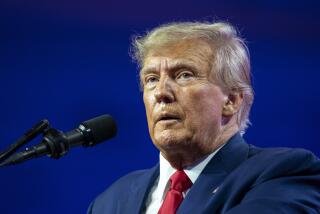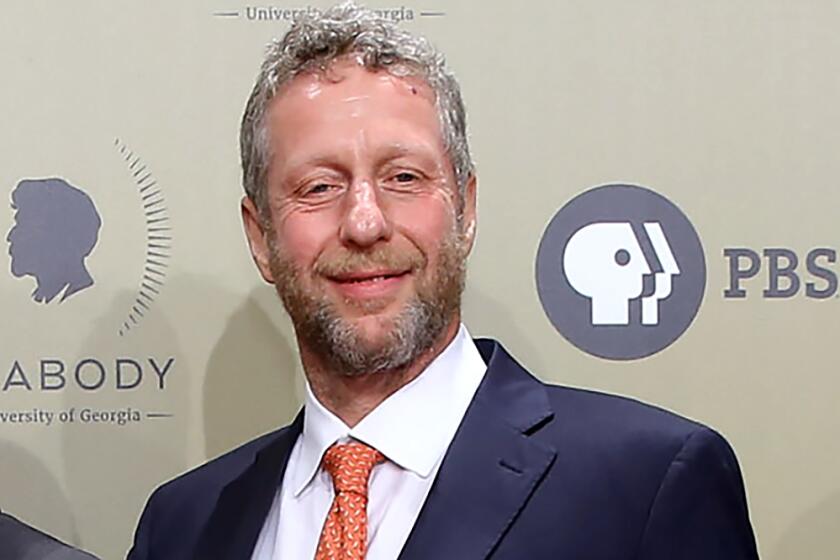SoCal stations would lose big in proposed Trump budget cuts for NPR and PBS

The Trump administration proposes dramatic cuts to the State, health and education departments while ramping up defense spending and $4 billion for construction of a border wall.
Proposed cuts to federal funding of public broadcasting conjure up images of Big Bird getting pink slipped from “Sesame Street.”
But the impact of the cuts would be a lot closer to home. President Trump’s budget blueprint, released Thursday, would eliminate support for the Public Broadcasting Service and National Public Radio.
About half of the $445 million provided every year to the Corporation for Public Broadcasting is distributed among 350 member stations to fund the operations of local PBS stations. Many of those outlets provide service to smaller communities who depend on free over-the-air television.
“If this stays at zero funding this is like the tsunami crashing onshore and it’s the little houses will get washed away first because they are totally dependent upon on it,” said Neal Shapiro, president of WNET, the New York flagship station of the Public Broadcasting System. “But then the big houses will start falling too because we are an interconnected system.”
Southern California’s KOCE station gets between 11% and 15% of its operating budget from the federal funds, or about $2.5 million to $3 million a year. But many of the PBS programs are produced by stations within the network, for example the station in Boston, and so the entire system could lose programs like “Frontline.”
“It would definitely be catastrophic,” said Andrew Russell, who is president and chief executive of PBS SoCal KOCE. “The public television system is interdependent and the federal financing is what makes it all work. All of the great PBS programming that everyone loves just wouldn’t be possible with the kind of cuts that they are proposing.”
Shapiro added that the public TV outlets most vulnerable to cuts are in rural areas likely to have voted for Trump in November.
If local TV stations can’t survive, that would ultimately hurt the larger outlets that create much of the programming such as “Nova” from WGBH in Boston and “PBS Newshour” from WETA in Washington that is distributed across the country.
Public radio stations in Southern California and nationwide would also be hit. KPCC 89.3 FM in Pasadena gets $1.3 million a year in federal funding, which represents 5% of its operating budget. KCRW 89.9 FM in Santa Monica receives about $1.2 million, which is 5.4% of its budget.
“It’s really scary,” said Jennifer Ferro, president of KCRW. “This is the biggest threat we have faced so far… the whole system will suffer because we really do rely on each other.”
For public radio, federal cuts would hurt the effort by stations to deliver local news — a job that many commercial radio outlets have abandoned due to consolidation and cost-cutting to service debt of their parent companies.
Bill Davis, president of Southern California Public Radio, which runs KPCC, said that losing the $1.3 million his station gets would jeopardize 12 full-time positions at the station. It’s unclear whether the station could make up that kind of income from its fundraising drives and sponsorships.
“It’s clearly something that we are worried about,” Davis said. “At this point we certainly don’t know and the message we are putting out is that membership support is more important than ever.”
Smaller public radio stations will be at risk of going off the air. Stations in Indiana, Texas, Alaska and other areas receive as much as 30% to 40% of their budget from the public funds because they don’t have access to big sponsors who can underwrite their programs.
The national organizations – PBS and NPR – rely on contributions from all of the stations throughout the country. So if smaller stations have to close their doors, that means NPR and PBS would get less funding overall and could pass along the cuts to the larger stations like KOCE, KPCC and KCRW.
PBS recently conducted a study that showed bi-partisan support for government funding of public broadcasting. The study found that 70% of those who voted for Trump say they would tell their elected representatives to find other places in the budget to save money if asked their opinion about eliminating federal funding for public television.
The number was even higher among voters in states that went from Democratic to Republican in the 2016 election, with 85% of voters wanting savings to come from somewhere other than public television.
Public TV stations are likely to hammer home those points to members of Congress who will have to go home and face the voters affected by the cuts.
Though public programming will most likely continue in some form without government money, its ability to reach rural areas is in greater jeopardy. Public radio and TV stations get an average of 19% of their revenue from the federal government, according to numbers from the Corporation for Public Broadcasting, a federally funded nonprofit entity that provides public dollars for public TV and radio stations. For some TV and radio stations, the figure rises to 50%.
Opponents of federal funding for public broadcasting often cite the private fundraising and corporate underwriting that help fund the Corporation for Public Broadcasting’s operational costs. While this would add up to significantly more pledge drives to help compensate for the lost government funding, the corporate influence that comes with accepting their funds runs into possible ethical questions that are contrary to public television’s mission.
In 2014, the Corporation for Public Broadcasting returned a $3.5 million grant from a Texas billionaire and former Enron official who helped fund a segment on “PBS Newshour” after it was learned that a ballot initiative in support of rolling back public employee pensions that was mentioned in the report was being partly funded by the same billionaire.
“There is no viable substitute for federal funding that ensures Americans have universal access to public media’s educational and informational programming and services,” Patricia Harrison, president and chief executive of the Corporation for Public Broadcasting, said in a statement, which also noted that the nonprofit provides children’s educational content and ensures public safety and homeland security through emergency alerts.
Critics also cite the increased availability of children’s programming elsewhere on cable networks and streaming services, including Netflix, Nickelodeon and HBO, the latter of which began broadcasting new episodes of “Sesame Street” in 2015 in an effort to offset production costs. Older episodes of the program still run on PBS.
But the loss of public television affiliates will affect poor families who may not be able to afford cable subscriptions.
Twitter: @SteveBattaglio
More to Read
Inside the business of entertainment
The Wide Shot brings you news, analysis and insights on everything from streaming wars to production — and what it all means for the future.
You may occasionally receive promotional content from the Los Angeles Times.








